Throughout history, Serie A was predominantly known for its obstinacy towards conservative football. The kings of ‘Catenaccio’ led the way for the art of defending in Europe.
Old school managers from days gone by such as Nereo Rocco, Helenio Herrera, Giovanni Trappatoni and a plethora of others caused Italian football to be painted with the lustrous brush of pragmatism for more than half a century.
Even still today, many ignorantly still proclaim that Italy is a destitute wasteland for attacking football. However, this is a fairly negligent assessment. Serie A is now one of the most attacking leagues in European football, averaging 3.08 goals per game, the most since the 1950/51 campaign.
Nevertheless, defending hasn’t just become frivolous and unimportant. It has merely transformed to fit the demands of the modern game. Teams now press high up the pitch as units to force their opponent into making errors in dangerous areas.
No team is more symbolic of this approach right now than Ivan Jurić’s Torino. The historic team from Turin are currently the highest pressing side in Italy, boasting the third-best defensive record in the top-flight division, conceding merely 19 goals all season. Only champions Internazionale and title-contenders Napoli have bettered this.
This article will be a tactical analysis of Torino as a team scout report. It will be an analysis of the side with a particular focus on their high-pressing tactics.
Defensive formation
Back three formations seemed to have been weeded out in recent years as coaches turned to more conventional systems such as the 4-3-3 and the 4-2-3-1. Now, back three systems are becoming fashionable again. To quote Edmund from King Lear: “everything is come full circle.”
Last season, during a harrowing and nervy campaign for the club where they staved off relegation by four points under two contrasting managers, Torino primarily used both the 4-3-1-2 and the 3-5-2.
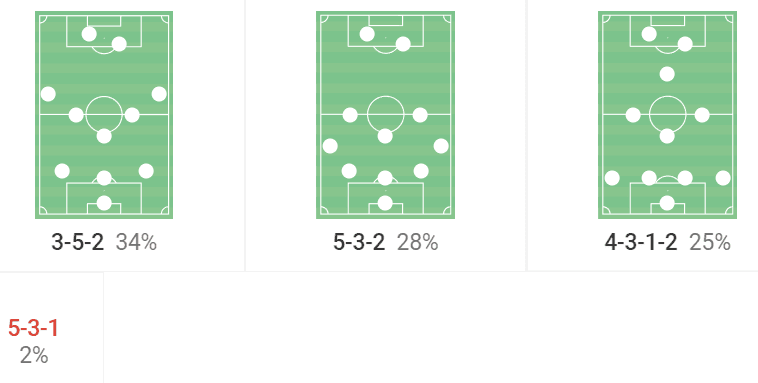
This season, the much-improved team under the former Hellas Verona coach Jurić, deploys a 3-4-3 which includes all variations of it such as the 3-4-2-1. They have used this in 62 percent of their matches in all competitions so far.
The 3-5-2 and 3-4-1-2 have also seen the light of day at the Stadio Olimpico Grande Torino di Torino but not as much as their sister formation with wingers.
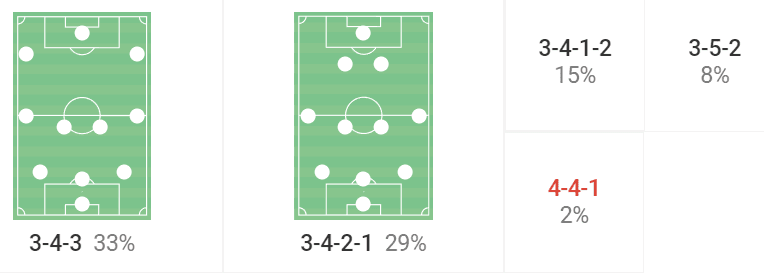
Analysing and quantifying formations in possession can be rather tedious in football discourse. Manchester City and Liverpool play in a 4-3-3 structure but how often are they actually in this shape? The answer is, probably not a lot.
In possession, Torino set up in a 3-2-5 shape, but quantifying formations works best during the defensive phases which is how one can differentiate whether Il Toro are using a 3-4-3 or a 3-4-2-1 in games.
Defensively, when the front three are wide, the formation can be labelled as a 3-4-3 whereas if they are defending narrower, the structure changes to a 3-4-2-1. Nonetheless, contextualising Torino’s defensive structure is quite difficult still, particularly in a high press. This will be analysed in closer detail later in this article.
How good is Torino’s press?
Torino’s high press is fascinating and one of the most extreme in Europe. In Serie A, the Turin-based side are the most intense pressers in the division with the lowest Passes allowed Per Defensive Action (PPDA) this season with 7.71.
The lower the PPDA, the less a team allows the opposition to have possession of the ball. Only Barcelona and 1. FC Köln have a lower PPDA in Europe’s top five leagues which is really impressive.
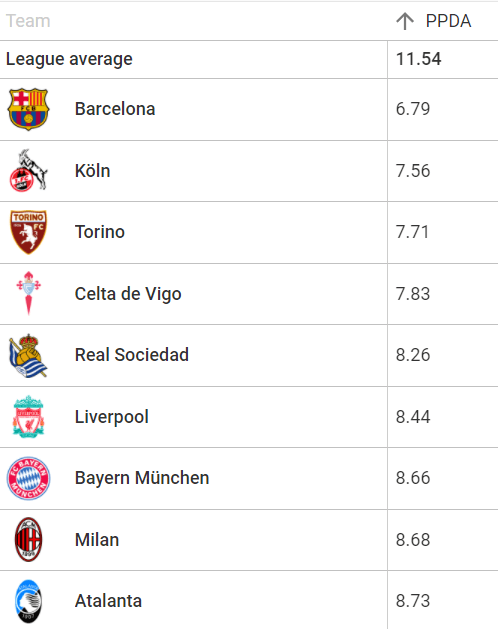
In fact, Torino have the lowest PPDA in Serie A so far this season while also boasting the joint-highest challenge intensity with Hellas Verona, Jurić’s former side. As cited by Wyscout, challenge intensity is “a team metric, quantifying how many defensive actions (defensive duels, loose ball duels, interceptions, tackles) a team is doing per minute of opponent ball possession.”
Torino’s challenge intensity this season is 6.9. In correlation with their immense challenge intensity and low PPDA, it proves that Torino are pressing a lot, and vigorously.
Regardless, while PPDA can measure how much a team applies pressure to the ball, it does not necessarily tell us too much about what areas of a pitch the team presses or how successful this is. Do Torino apply a lot of pressure in the final third? Do they press well?
In short, the answer to both is a resounding yes. Jurić’s team are currently averaging 36 pressures in the final third per 90. Only Milan, Napoli and Empoli are bettering this. They also boast the second-highest successful pressure percentage in the league.
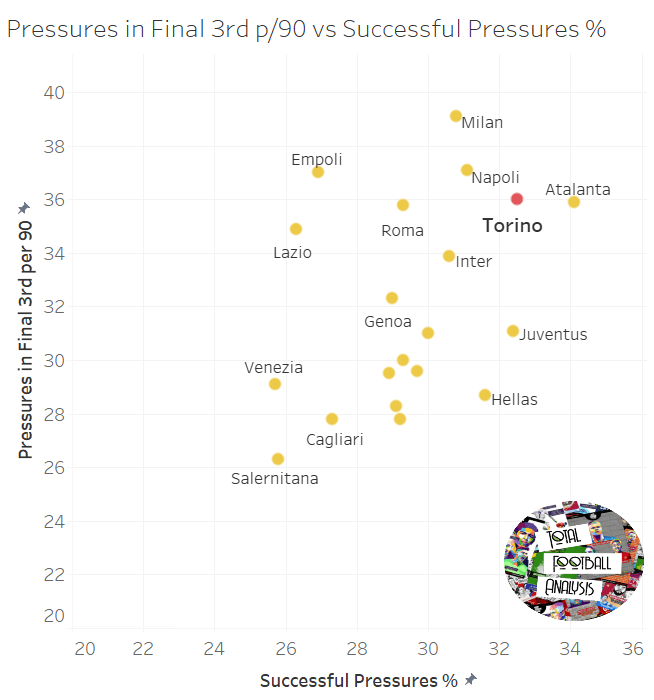
The work that Jurić has done on the training ground with the players has worked wonders with the side. Last season, Torino ranked as the sixth-worst team for pressures in the final third per 90 under Marco Giampaolo and Davide Nicola, averaging 29.8 per game.
As well as this, Il Toro had a successful pressure percentage of 28.8 merely percent per 90 throughout the course of the 2020/21 campaign in Serie A. The statistics are blindingly-obvious evidence of improvement as well as a representation of the tactical development that the team have gone through since the Croatian manager took over in the summer.
Similarities to Leeds and Atalanta in the high press
The evidence has been laid out firmly on the table that Torino are a team that press high and rather successfully. Now, let’s take a look at exactly how they press.
Torino press in a man-oriented fashion. This is one of the most common pressing schemes in world football. It does exactly what it says on the tin. In the high block phase, a player is assigned a marker whom he must press. Under Jurić, this is rather strict, and the players must adhere to the coach’s tactical orders to fully execute the press efficiently.
The players will be given different men to mark in each game and the instructions will alternate depending on the opposition’s structure.
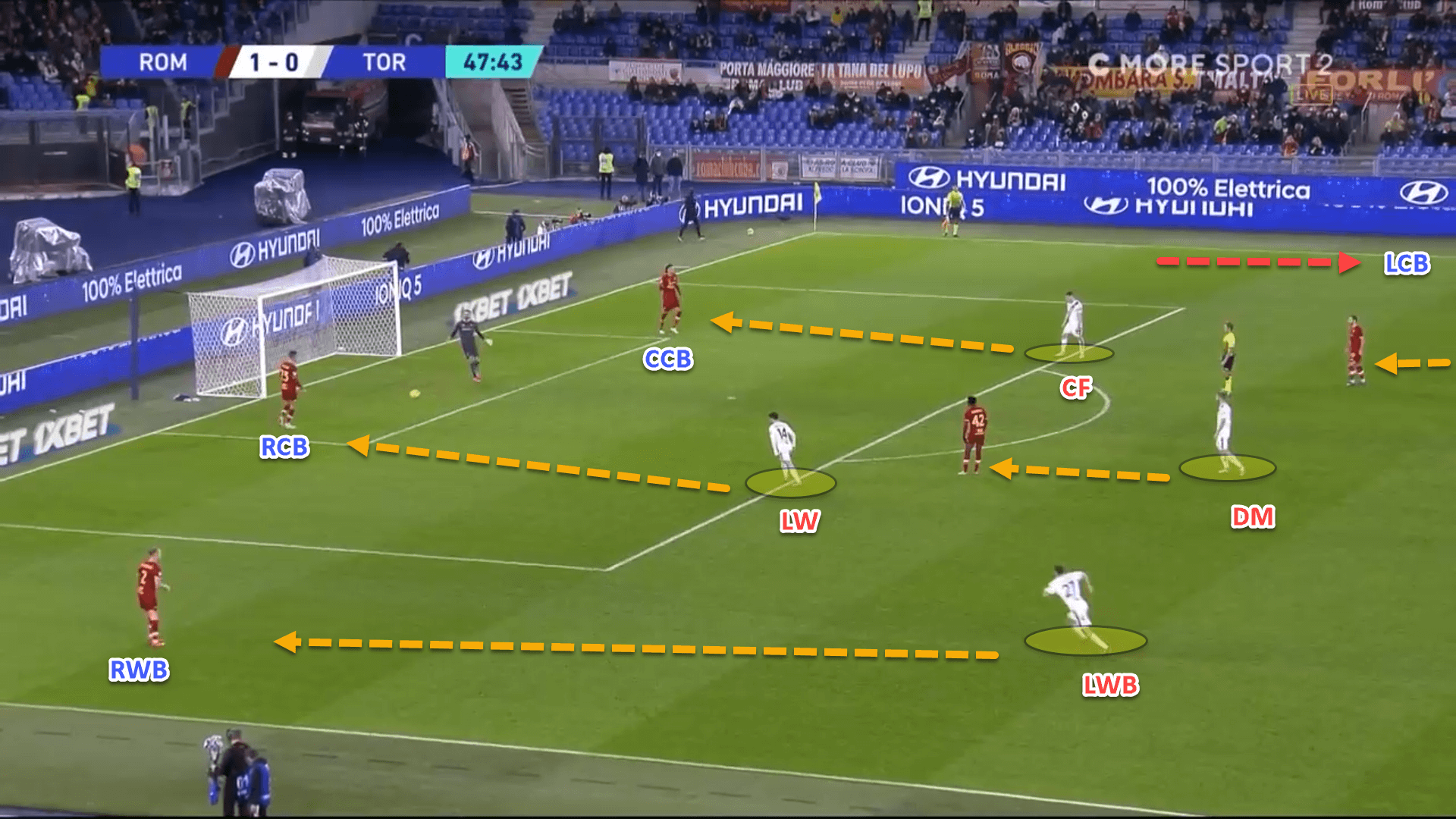
Pressing a back three is different to pressing against a back four. At the same time, going man-to-man against a three-man midfield involves different tasks compared to a two-man midfield.
In this example, Torino are defending in a high-block against AS Roma’s back three which has become a four as the left centre-back has pushed higher, playing as a fullback while the right wingback has dropped to create a temporary back four as they are trying to play out from the back.
As is evident from the scenario, Torino’s players are following their men closely with the left wingback, Mërgim Vojvoda, pressing Roma’s right wingback who has dropped low to receive the ball. Meanwhile, on the far side, Torino’s right-winger has tracked the left centre-back from Roma who has advanced forward.
When Roma returned to their original base formation 3-5-2, Torino continued to adhere to the strict man-oriented structure, reverting to more of a 3-4-2-1/3-4-3 shape.
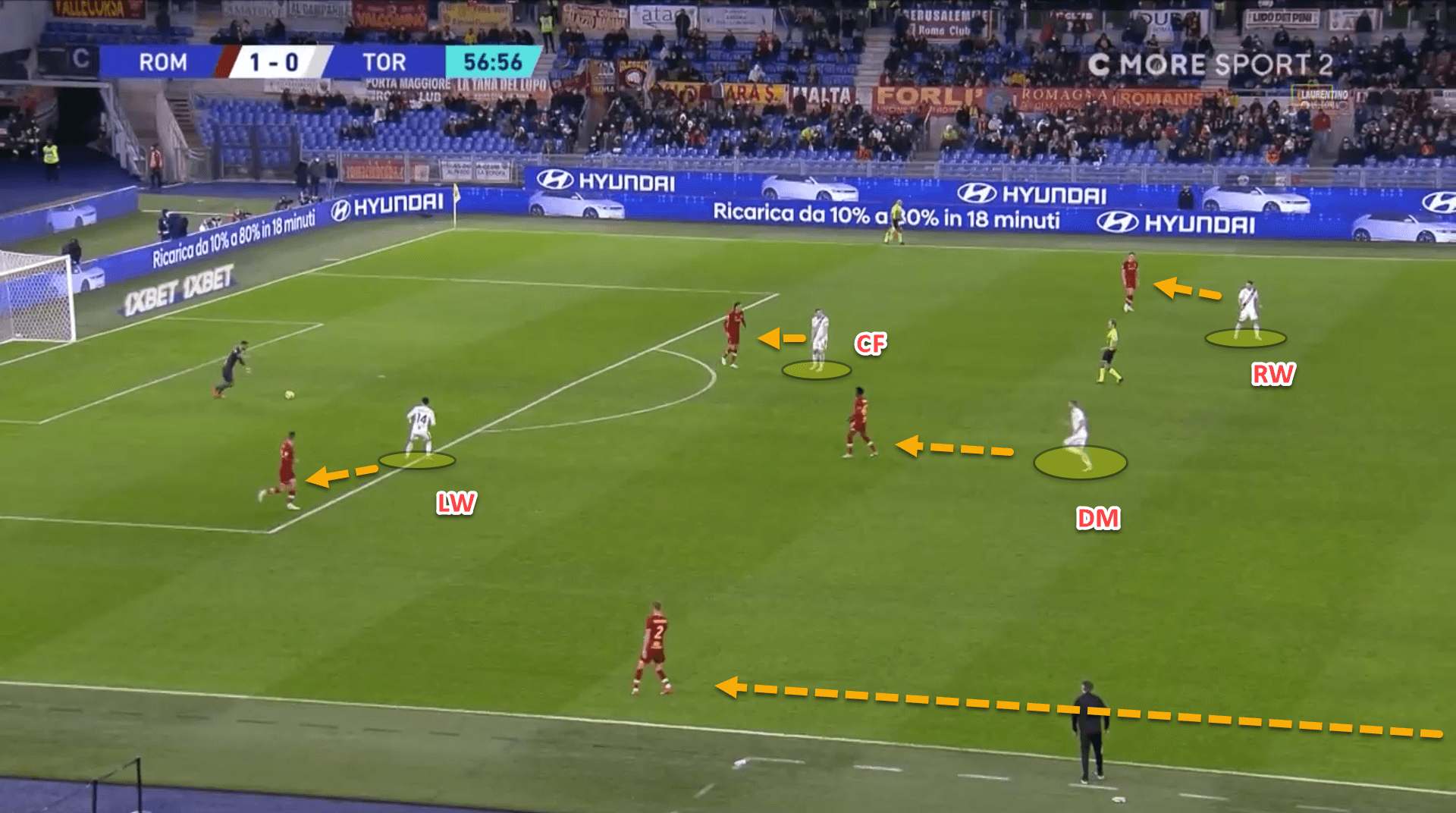
The objective of the high press is the same as any team’s. Torino will try and shape their pressure to force the defensive team to play to the sides where they will shuttle across, close off the nearest passing options and look to regain possession.
Forcing the attacking team wide is useful because it allows the defending side to use the touchline as an extra man since there is less of the pitch for the ball-carrier to play to.
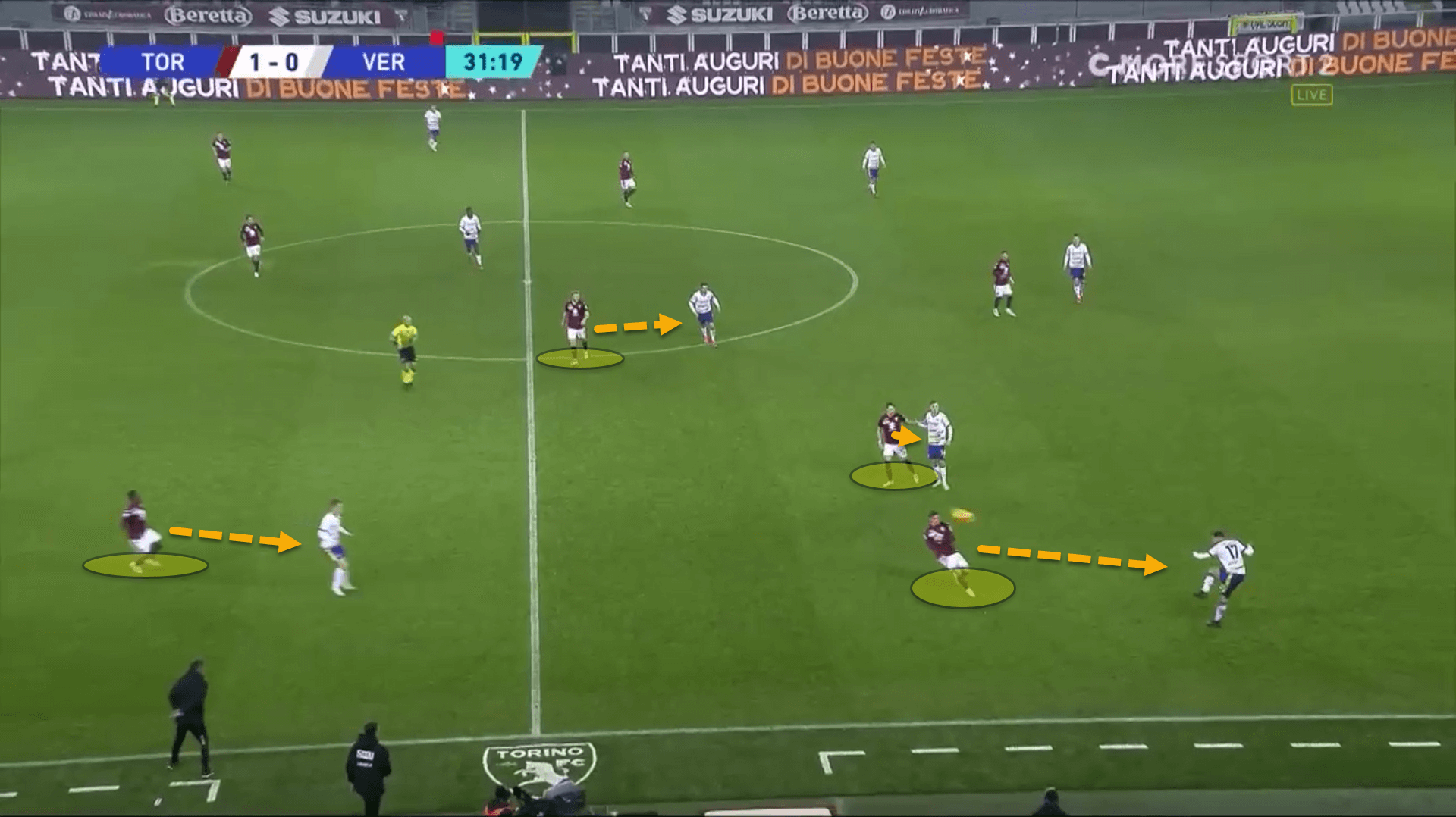
Of course, in using a 3-4-3/3-4-2-1, there are only two central midfield players. This is not necessarily a problem, but it leaves Torino outnumbered against three-man midfields.
If there was no game-plan to tackle the numerical inferiority in the middle of the pitch, it would be far too easy to bypass their pressure and play to the free man to progress the ball higher up the field.
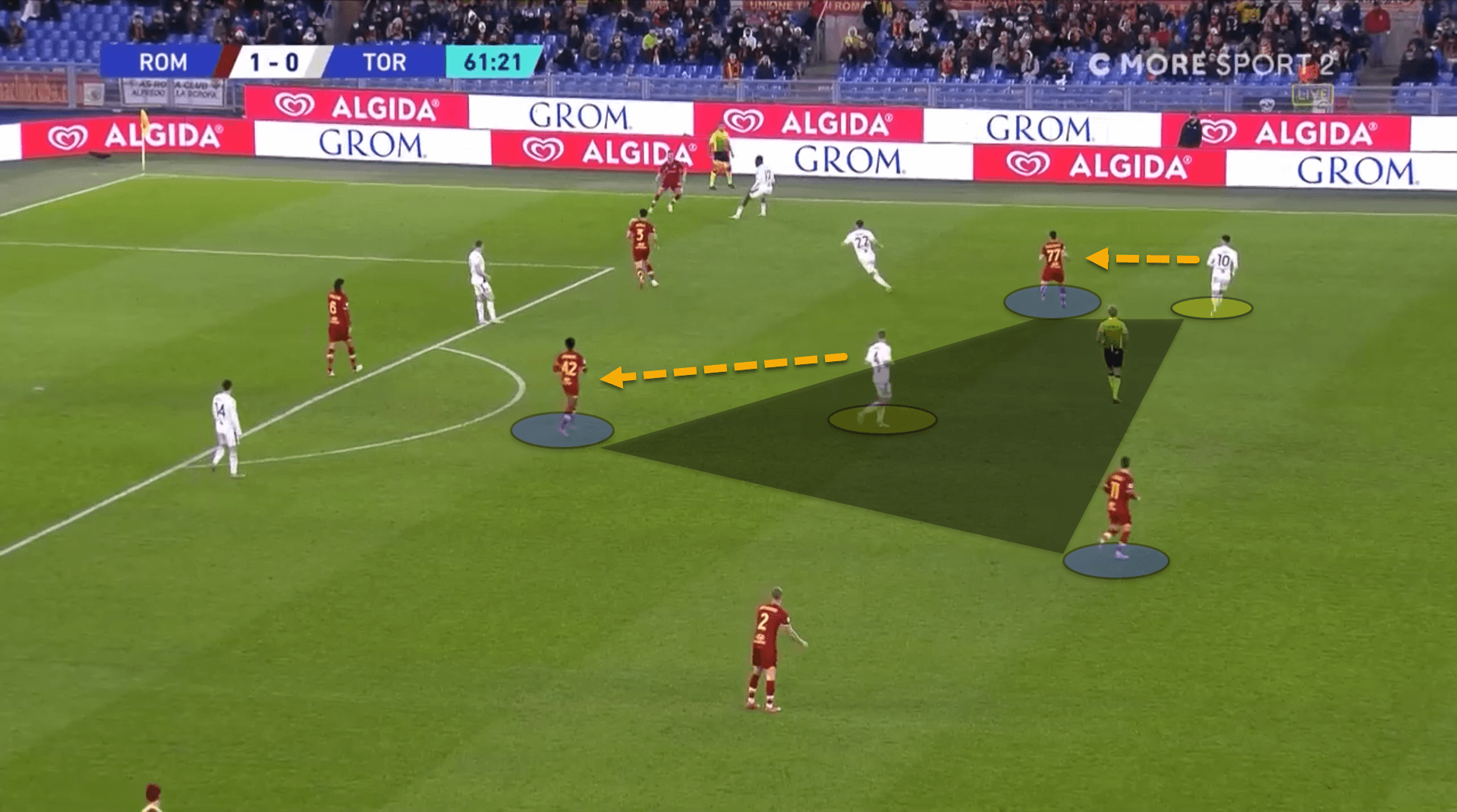
Here, Torino are pressing Roma high. The double-pivot are occupied with two of their opponent’s three central midfielders which has left the third, Henrikh Mkhitaryan, free to receive the ball in space. Ultimately, Roma are unable to use this to their advantage but the opportunity to do so was still plausible.
So the question is; how exactly do Torino defend against a three-man midfield in a strict man-marking system so as to ensure that the attacking side cannot constantly use the free man in possession?
The answer is to allow one of the three centre-backs to man-mark the free player. Torino do this incredibly well which makes for some humorously fascinating viewing. In a recent tactical clash against Inter, Alessandro Buongiorno – who was deployed as the left centre-back in three – stuck tightly to Arturo Vidal.

Here, Torino are in their high block, tightly marking all over the pitch. The double-pivot are occupied, sticking to their own men. Buongiorno has pushed up from the backline to mark Vidal in order to prevent the attacking side from having a free passing lane.
Buongiorno performed this role excellently. The game overall was a superb watch from a neutral and analytical perspective. One way the Serie A champions attempted to combat Torino’s unconventional pressing shape was by persistently rotating the midfield.
At times, Vidal would be the deepest midfielder looking to receive from the goalkeeper. However, Torino stuck true to their principles. Buongiorno followed Vidal regardless of how deep he dropped which made for the most extraordinary of defensive shapes.
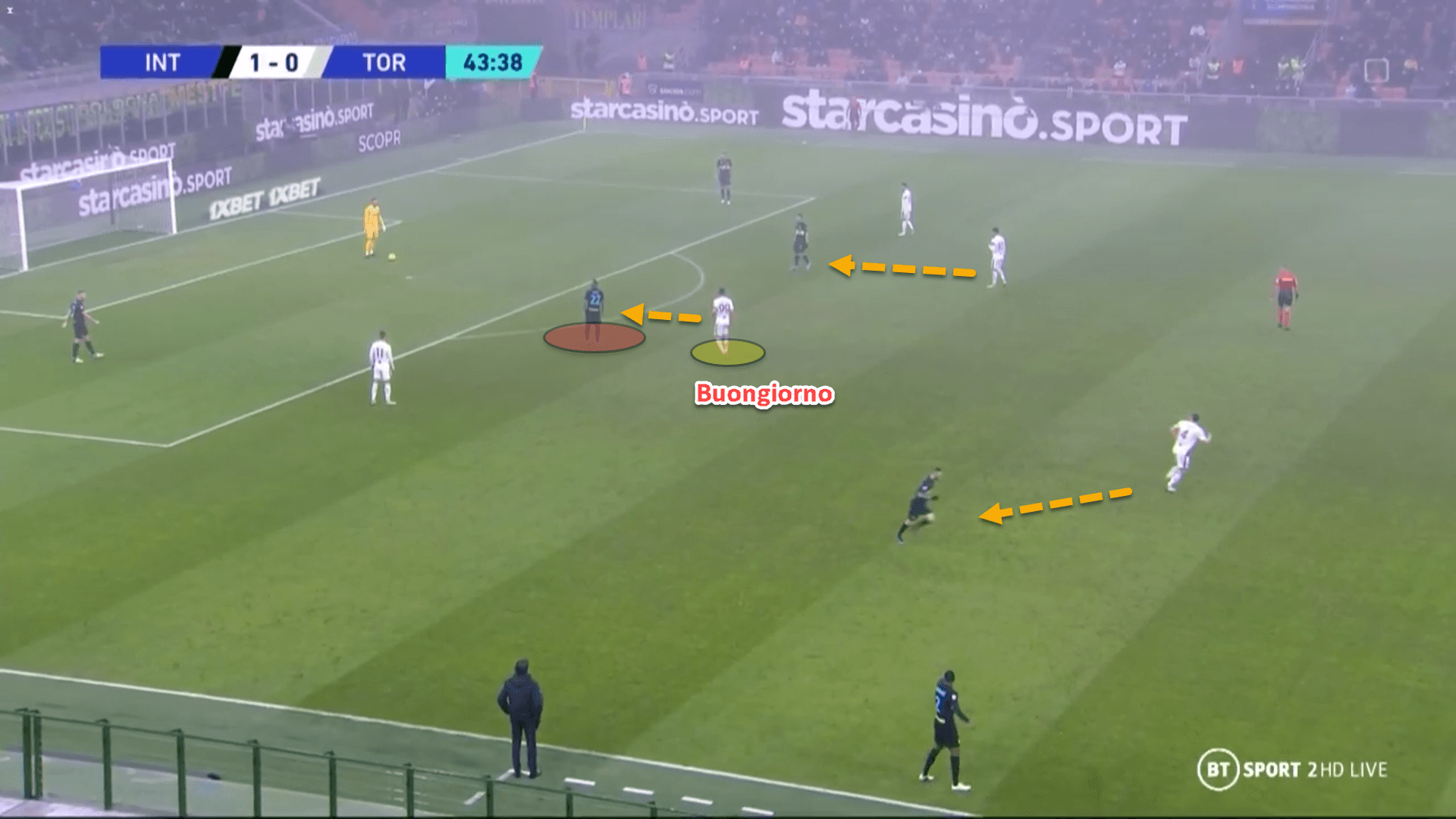
This type of defending, with little to no marker-sharing, is a sort of atavistic commemoration of football in the past where extreme man-marking was the dominant defensive system before being replaced by zonal marking and defensive blocks by the 2000s.
Torino’s pressing system can only really be compared to that of the Premier League’s Leeds United or league rivals Atalanta in Europe right now for its unorthodox approach.
While it relies heavily on players winning their individual defensive battles, it can be ridiculously difficult to play against when in full flow as players will get very little time and space on the ball in comparison to playing against a zonally defensive team.
Torino are excellent in their defensive duels, winning 62 percent of their total duels this season in all competitions and so relying on man-to-man defending is something that they are competent in doing, far more than their horrendous zonal defending last season.
How to break it
Man-marking systems have huge benefits as, in full swing, they can be extremely dogged to play against. However, there are weaknesses, of course, which Torino come across in almost every game.
A major weakness of man-marking system is that the system can easily be disjointed by a centre-back simply breaking it by carrying the ball past the first line of pressure. This happens to Leeds an inconceivable amount.
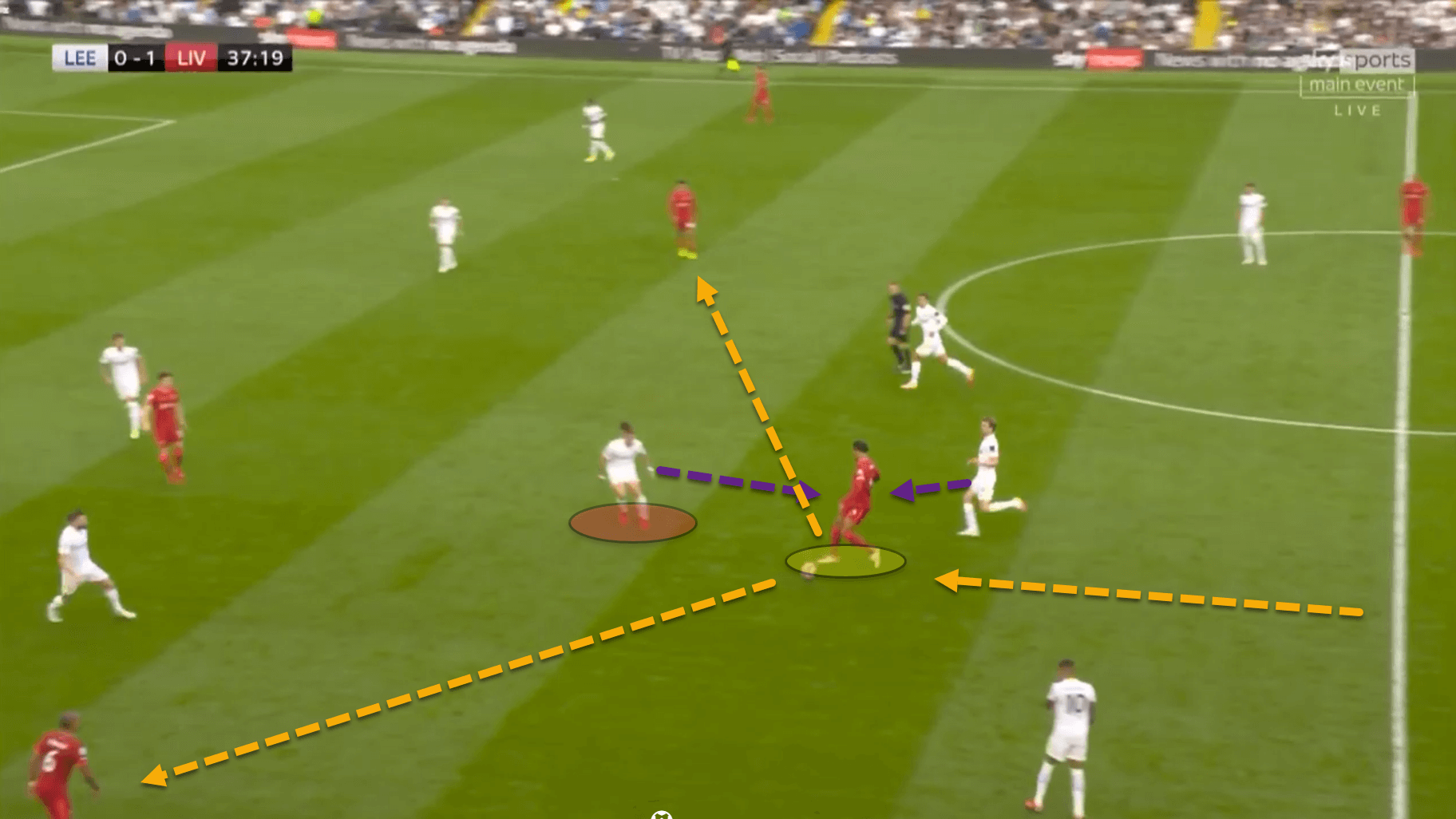
Here, Virgil van Dijk has dribbled past Patrick Bamford’s pressure in Leeds’ man-oriented system, which sets off a ripple effect of dis-marking further up the pitch. Kalvin Phillips has been forced to engage with the Dutch centre-back, leaving his man to be picked up by a teammate.
Nonetheless, it causes the Leeds right-back to be outnumbered 2v1 against Thiago and Sadio Mane (out of the picture on the left).
This is a weakness for Torino too, but their main weakness doesn’t come from defenders making runs to bypass the press. Instead, their deficiencies stems from the goalkeeper being unmarked.
It sounds strange, but Torino rarely presses the goalkeeper. They generally go 10v10 outfield with no room to press the man between the sticks. In fact, their choice to not press the keeper makes them really difficult to bypass as little dis-marking can occur.
However, if they are playing against a goalie with good distribution, he is able to ping direct passes to the centre-forwards. As Torino defend man-to-man against the centre-forwards too, it becomes a simple case of winning the first contact of the ball in the air.
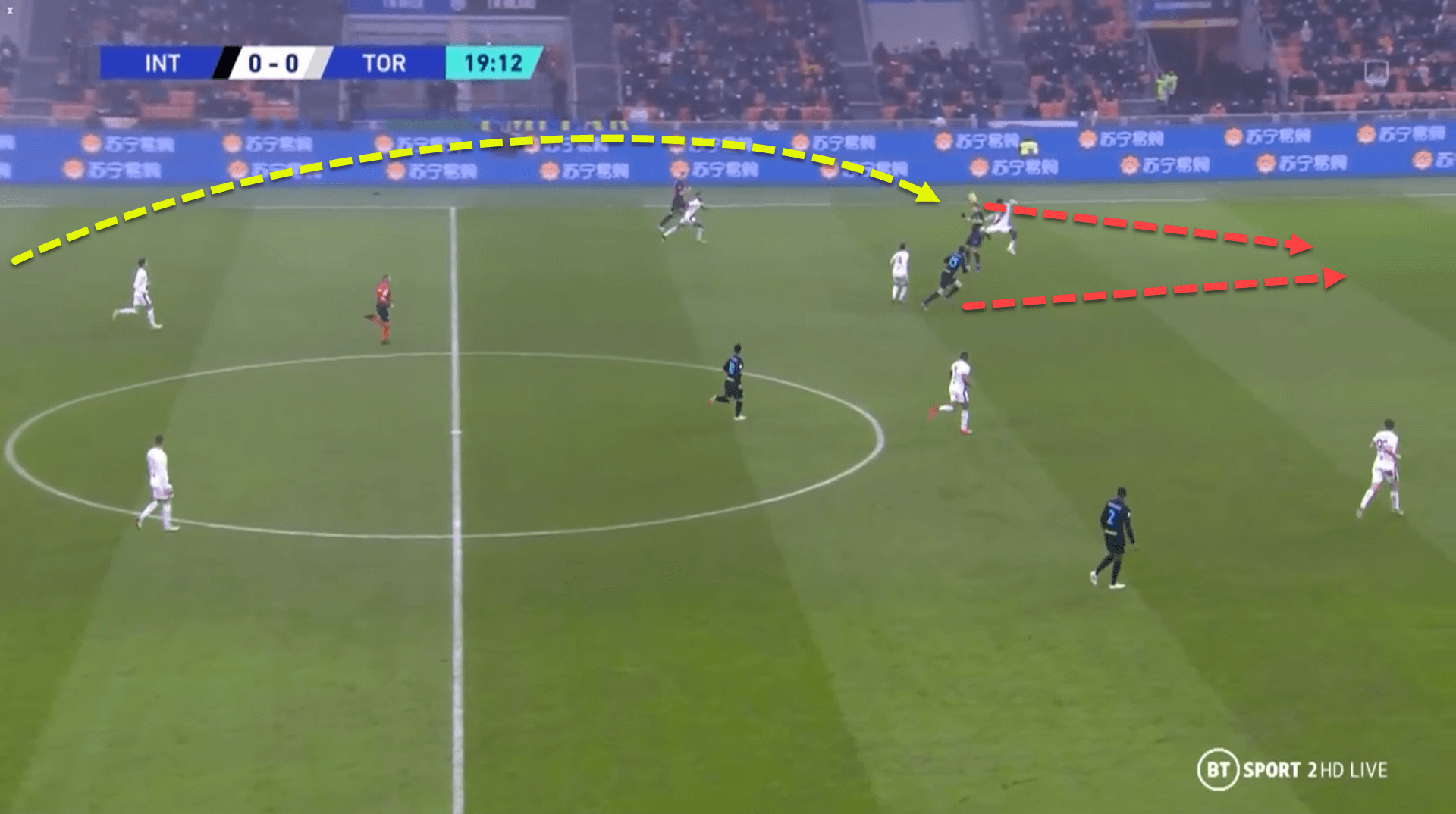
In this situation presented in the above image, Inter’s keeper, Samir Handanović, has all the time in the world to pick his pass as he is under no pressure at all. The Slovenian lofts the ball up the pitch towards the notoriously aerially-dominant Edin Džeko. Torino’s nearest centre-back contests the ball but is easily beaten, leaving space behind him for Džeko to flick the ball into for a runner.
If you can’t beat a press by playing through it or around it, play over it. This doesn’t mean that Torino can’t defend these duels, but they have tallied merely a 45 percent aerial duel success rate in all competitions this season.
Conclusion
Il Toro have conceded an xG of just 21.65 this season, the third-lowest in Serie A. Once more, only Inter and Napoli have bested this, but Torino’s squad is certainly not compatible with the other two sides in terms of the quality of players available to each head coach.
One of the main factors behind the historic Italian team’s wonderful defensive record is their high press. Teams find it really tough to bypass their press by playing on the floor due to the intensity of their system. It has allowed them to have one of the best defences in Europe’s top five leagues too.
Ivan Jurić deserves full credit for the work done at the Stadio Olimpico Grande Torino di Torino, turning the team around from a sluggish and lethargic one to one of the most energetic and exciting in European football.






Comments